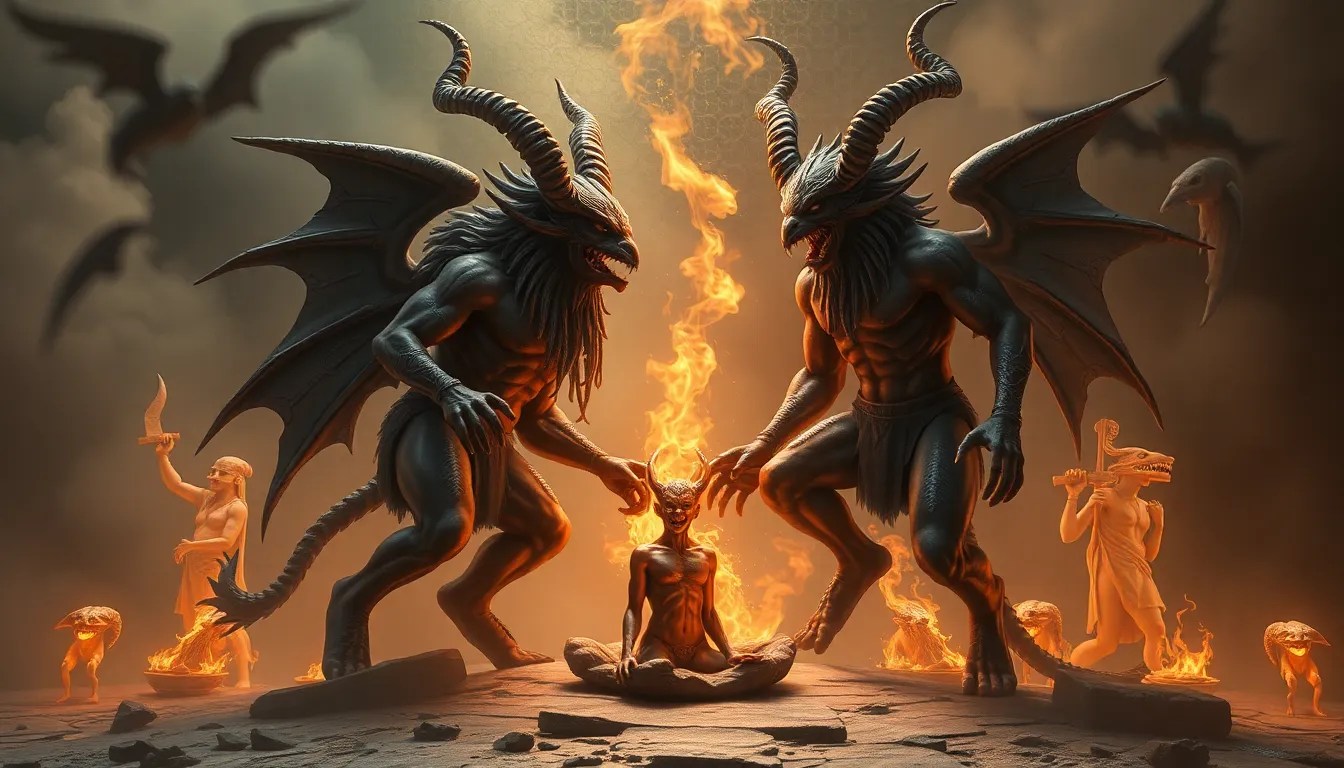The Intersection of Babylonian Demons and Ancient Medicine
I. Introduction
Babylonian mythology, a rich tapestry of beliefs and narratives from ancient Mesopotamia, plays a significant role in understanding the culture and practices of the time. This mythology is characterized by a pantheon of gods, spirits, and demons, which were integral to daily life and the interpretation of natural phenomena.
Demons, in particular, held a multifaceted role in Babylonian culture. They were viewed not only as malevolent beings but also as entities that could protect or curse individuals. The intersection of these demons with ancient medical practices is a fascinating area of study, shedding light on how the Babylonians understood health, illness, and the supernatural.
This article will explore the complex relationship between Babylonian demons and ancient medicine, revealing how spiritual beliefs influenced medical practices and perceptions of health in Babylonian society.
II. Understanding Babylonian Demons
Babylonian demons were classified into various categories, each with distinct characteristics and roles. Some were seen as harbingers of disease and misfortune, while others were considered protectors.
A. Characteristics and classifications of Babylonian demons
- Malevolent Demons: These were believed to cause illness and suffering.
- Protective Demons: Entities that provided safety and health to individuals.
- Neutral Spirits: Beings that could influence events but were not inherently good or evil.
B. Notable demons in Babylonian mythology
Some of the most notable demons include:
- Pazuzu: The demon of the southwest wind, often invoked for protection against other malevolent spirits.
- Lilitu: A female demon associated with storms and disease, sometimes linked to childbirth complications.
C. Cultural perceptions of demons: Harbingers of disease or protectors?
In Babylonian culture, demons were perceived as dual entities capable of both harm and healing. While they could be seen as causes of disease, many were also invoked for protection and healing, illustrating the complex nature of belief in the supernatural.
III. Ancient Babylonian Medical Practices
The medical knowledge of ancient Babylon was sophisticated, grounded in a mixture of empirical observation and spiritual beliefs. Healers, often priests, utilized a blend of herbal remedies, surgical techniques, and rituals to address ailments.
A. Overview of medical knowledge in ancient Babylon
Babylonian medicine was influenced by the knowledge accumulated over centuries, incorporating wisdom from various cultures within Mesopotamia. Medical texts revealed the understanding of anatomy, disease processes, and a range of treatments.
B. Common ailments and treatments used by Babylonian healers
Common ailments included:
- Infections and fevers
- Digestive issues
- Childbirth complications
Treatments varied widely, from poultices and potions to more invasive procedures.
C. The role of ritual and incantation in healing practices
Rituals and incantations were essential components of Babylonian medicine. Healers believed that invoking the right words and performing specific rituals could drive away demons and restore health.
IV. The Role of Demons in Health and Illness
Demons were often blamed for various diseases, with specific entities associated with particular ailments.
A. Beliefs regarding demons as causes of disease
Many Babylonians believed that illness could be a direct result of demonic influence, leading to a focus on spiritual cleansing as part of medical treatment.
B. Protective demons and their significance in medical rituals
Protective demons were invoked during medical rituals, serving as intermediaries between the patient and the divine. Their presence was believed to safeguard the healing process.
C. Case studies of specific conditions attributed to demonic influence
Conditions such as epilepsy and mental illness were often viewed through the lens of possession by harmful spirits, necessitating specific rituals for healing.
V. Healing Rituals and Exorcisms
Exorcism was a key practice in Babylonian medicine, aimed at expelling harmful demons from afflicted individuals.
A. Description of exorcism practices in Babylonian medicine
Exorcisms involved elaborate rituals, including prayers and the recitation of incantations meant to banish demons.
B. Use of amulets, incantations, and offerings in healing rituals
Healers frequently employed:
- Amulets inscribed with protective symbols
- Incantations recited to invoke the favor of protective deities
- Offerings made to appease spirits
C. The collaboration between priests and healers in combating demons
Collaboration between priests and healers was crucial in the treatment process, blending spiritual and physical healing methods.
VI. Textual Evidence from Babylonian Sources
Numerous ancient texts provide insights into the beliefs and practices surrounding demons and medicine.
A. Analysis of relevant texts (e.g., the Enuma Elish, medical tablets)
Texts like the Enuma Elish reveal the cosmological beliefs that informed Babylonian medicine, while medical tablets document specific healing practices and demonology.
B. Insights from inscriptions and artifacts regarding medical practices
Inscriptions on artifacts often depict scenes of healing rituals, showcasing the integration of spiritual and medical practices.
C. Interpretation of demonology in the context of healing texts
Understanding demonology within healing texts highlights the cultural significance of these beliefs and their impact on health and illness.
VII. Comparative Perspectives: Demons and Medicine in Other Cultures
The role of demons in medicine is not unique to Babylonian culture but can be seen across various ancient civilizations.
A. Similarities between Babylonian beliefs and other ancient cultures
Many ancient cultures, including Egyptian and Greek, shared similar views on the influence of demons and spirits on health.
B. Cross-cultural examination of demons in healing practices
Comparative studies reveal a cross-cultural understanding of the relationship between supernatural beliefs and medical practices, showcasing universal themes in human health.
C. The enduring legacy of these beliefs in modern medical practices
Many modern medical practices still reflect ancient beliefs, particularly in cultures that incorporate traditional healing alongside contemporary medicine.
VIII. Conclusion
The exploration of Babylonian demons and ancient medicine reveals a complex interplay between spirituality and health. Demons were viewed as both causes of disease and protectors, influencing medical practices in profound ways.
These ancient beliefs continue to impact contemporary understandings of health and illness, demonstrating the lasting legacy of Babylonian mythology. Future exploration of ancient mythologies can provide further insights into the evolution of medical history and cultural beliefs.



